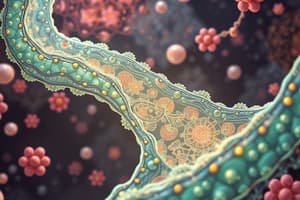Podcast
Questions and Answers
What is the role of the gel-layer resistance next to the membrane in ultrafiltration units?
What is the role of the gel-layer resistance next to the membrane in ultrafiltration units?
- Decreases the concentration gradient
- Facilitates solvent flux
- Enhances solute back diffusion
- Increases resistance to solvent flux (correct)
In the gel-polarized regime, what determines the solvent flux in ultrafiltration units?
In the gel-polarized regime, what determines the solvent flux in ultrafiltration units?
- Pressure difference
- Concentration gradient
- Back diffusion equation (correct)
- Gel-layer resistance
What type of solutions have experimental data confirmed the use of Eq.(24.5-6) for in ultrafiltration units?
What type of solutions have experimental data confirmed the use of Eq.(24.5-6) for in ultrafiltration units?
- Dilute solutions only
- Macromolecular and colloidal solutions (correct)
- Homogeneous solutions
- Inorganic solutions
What does a reverse osmosis membrane allow to pass through while impeding the passage of other substances?
What does a reverse osmosis membrane allow to pass through while impeding the passage of other substances?
Which factor plays a critical role in determining the volume of pure solvent water associated with a certain amount of solute in reverse osmosis?
Which factor plays a critical role in determining the volume of pure solvent water associated with a certain amount of solute in reverse osmosis?
What size of suspended materials can be removed using reverse osmosis according to the text?
What size of suspended materials can be removed using reverse osmosis according to the text?
Which membrane configuration has the highest ratio of membrane area per unit volume?
Which membrane configuration has the highest ratio of membrane area per unit volume?
What is the typical pressure drop range for ultrafiltration units?
What is the typical pressure drop range for ultrafiltration units?
In the flux equation for ultrafiltration, what can be neglected?
In the flux equation for ultrafiltration, what can be neglected?
What phenomenon occurs when the solute concentration builds up at the membrane surface?
What phenomenon occurs when the solute concentration builds up at the membrane surface?
What happens to the solvent flux as the pressure drop increases?
What happens to the solvent flux as the pressure drop increases?
What is the primary effect of a higher convective transport of the solute to the membrane?
What is the primary effect of a higher convective transport of the solute to the membrane?
What is the relationship between the convective flux and the diffusion flux at steady state?
What is the relationship between the convective flux and the diffusion flux at steady state?
What is the effect of further increases in pressure drop on the ultrafiltration process?
What is the effect of further increases in pressure drop on the ultrafiltration process?
Which equation describes the relationship between the mass-transfer coefficient and the solute concentration at the membrane surface?
Which equation describes the relationship between the mass-transfer coefficient and the solute concentration at the membrane surface?
What is the effect of concentration polarization on the ultrafiltration process?
What is the effect of concentration polarization on the ultrafiltration process?
Flashcards are hidden until you start studying
Study Notes
Convective Transfer and Gel-Layer Resistance
- In the gel-polarized regime, the net flux of solute by convective transfer equals the back diffusion of solute into the bulk solution due to the polarized concentration gradient.
- The added gel-layer resistance next to the membrane causes an increased resistance to solvent flux, which is determined by 𝑁𝑤 = ∆𝑃 1 𝐴𝑤 + 𝑅𝑔.
- The solvent flux in this regime is independent of pressure difference and is determined by the back diffusion equation.
Reverse Osmosis Membrane Process
- In reverse osmosis, a spontaneous transport of solvent occurs from a dilute solute or salt solution to a concentrated solute or salt solution across a semipermeable membrane.
- The osmotic pressure is given by the equation π = nRT / Vm, where n is the number of kg mol of solute, Vm is the volume of pure solvent water, R is the gas law constant, and T is temperature in K.
Ultrafiltration
- In ultrafiltration, the membrane does not allow passage of the solute, which is generally a macromolecule.
- The flux equation for ultrafiltration is 𝑁𝑤 = 𝐴𝑤(∆𝑃), since the osmotic pressure is very low and can be neglected.
- Ultrafiltration units operate at a lower pressure drop (5-100 psi) compared to reverse osmosis (400-2000 psi).
Concentration Polarization
- In ultrafiltration, the solute is rejected by the membrane and accumulates at the surface of the membrane, leading to concentration polarization.
- As pressure drop increases and/or concentration of the solute increases, concentration polarization occurs, which is more severe than in reverse osmosis.
- The convective flux equals the diffusion flux at steady state: 𝑁𝑤𝐶 ρ = − 𝐷𝐴𝐵 𝑑𝑐 / 𝑑𝑥.
Studying That Suits You
Use AI to generate personalized quizzes and flashcards to suit your learning preferences.




